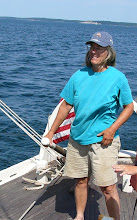Last Spring I wrote about the approval of Canada's National Energy Board to allow the re-purposing of an old pipeline for transporting tar sands crude. Line 9B also known as the Black Snake runs along the north shore of Lake Ontario and crosses dozens of creeks rivers and wetland areas like the one pictured above. Now, about three weeks ago, we see the Lake Ontario Waterkeeper site has posted the following.
“Yesterday, the National Energy Board put Enbridge’s Line 9B pipeline project on hold until the company proves it is taking reasonable precautions to protect our drinking water.
Line 9B was originally designed to move natural gas, not bitumen along Lake Ontario. Because the danger of piping bitumen far surpasses the risk of piping natural gas, the increased risk to our environment demands greater precaution.
The NEB’s focus on water protection is warranted, if only because 40 million people rely on the Great Lakes for drinking water.
Demanding Enbridge build emergency shut down capacity on its Line 9B pipeline when crossing rivers is totally justified and reasonable.
Further, the NEB’s decision sends an important signal beyond Line 9B. It will apply to other projects, such as with the 3A-West African Gas Pipeline and the Energy East Pipeline.
Many Canadians have rightly become alarmed at the federal government’s efforts to lower the bar for approvals of major energy projects through its narrowing of public approvals and weakening the Navigable Waters Protection Act and Fisheries Act.
The NEB’s decision to stand firm on protecting watersheds by demanding safety shutdowns near rivers and key water crossings has raised the bar back again – at least a little, at least for now.”
The Waterkeeper update follows a
previous decision back in June to allow the Chippewa tribe legal
standing in Canada's Federal Court of Appeals re Line 9B. Under
Canadian Constitution the First Nation Inuit and Metis peoples must
be consulted by treaty on land use issues that can impact their
territories. Line 9 B crosses the Thames River that supplies this
Chippewa band with drinking water.
A website titled chiefs-of-ontario.org
states “Deshkaan Ziibing (that translates as the Chippewas of the
Thames) demonstrated during the Line 9 public hearings held last
October that its members exercise
their rights by means of traditional practices (hunting, fishing,
harvesting) in the area occupied by Line 9, the Thames River valley
in case of Deshkaan Ziibing. A Line 9 rupture and the difficulties of
adequately cleaning up a bitumen spill in particular would infringe
upon Deshkaan Ziibing members' ability to exercise these rights.”
Now admittedly the track record of the
U.S. and Canada in honoring treaties with the aboriginal peoples of North America is less than stellar. But still,
one wonders if the Chippewa appeal has possibly influenced the
National Energy Board to take another look at things. Re-purposed old
pipelines have a pretty bad track record with tar sands crude. Several such
lines including the 6B line owned by Enbridge (owner of 9B) that
crossed a tributary of Lake Michigan and the Pegasus line in Arkansas
have failed resulting in catastrophic spills.The 2010 Michigan spill
of over a million gallons of tar sand crude into a tributary of the
Kalamazoo River is the most costly inland spill ever to date.
There is evidence that the tar sands
crude is particularly hard on old pipes because of its physical
characteristics though the industry vigorously denies this. Tar sand
crude's high viscosity, the theory goes, can stress old pipes through large
fluctuations of pressure as it moves through the line. Reversing
flows in pipes as is proposed for Line 9B may aggravate existing
metal fatigue problems even further, as the pressure fluctuations now
hit in different areas of the pipe than were previously stressed. An analysis of the Pegasus Line
in Arkansas showed that manufacturing and welding methods of the time
left tiny “hook cracks” that may have been enlarged by the
movement and chemistry of the tar sands crude.
Stream crossings and other critical
areas should have thicker walled or double walled pipelines with
safety shut offs on each side. They should also have enhanced leak
detection alarms. If the tribes can achieve that much with their
court case it is at least a minimal precaution!


No comments:
Post a Comment